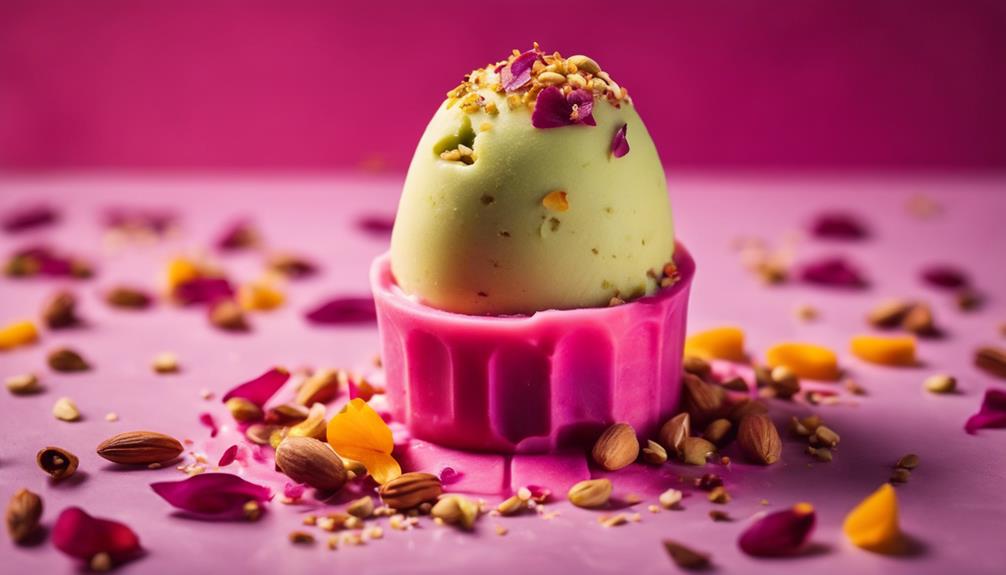On a scorching summer day, ice cream can quickly melt due to its high fat content, stabilizers, and sugar content. The heat causes these ingredients to break down, accelerating the melting process. The interaction between fat and stabilizers impacts how quickly your treat becomes runny. If you’re interested in understanding why various ice cream types melt at different rates or looking for tips to prevent rapid melting, continue exploring the intriguing science behind this delectable dessert.
Key Takeaways
- Higher temperatures increase ice cream's exposure to heat.
- High fat content insulates ice cream, slowing melting.
- Lack of stabilizers accelerates melting on hot days.
- Sugar content influences melting rate in warm conditions.
- Understanding fat content and stabilizers aids in predicting melting on hot days.
Factors Affecting Ice Cream Melting

Factors influencing the rate at which ice cream melts include temperature, fat content, stabilizers, and sugar content.
The fat content in ice cream plays a significant role in its melting behavior. Ice creams with higher fat content tend to melt slower as fats act as insulators, reducing heat transfer.
Stabilizers like gelatin and guar gum also impact melting rates by maintaining the structure of the ice cream and slowing down the melting process. These stabilizers help prevent the formation of large ice crystals, thereby keeping the ice cream solid for longer periods.
Understanding the interplay between fat content and stabilizers is essential in determining how quickly ice cream melts. While fat content affects heat transfer, stabilizers work to maintain the ice cream's texture and structure, ultimately influencing the overall melting rate.
Types of Ice Cream and Melting Rates

Ice cream with dairy fat tends to melt slower than gelato and sorbet, mainly due to its higher fat content. Gelato, with less dairy fat than traditional ice cream, typically melts slower, while sorbet, containing no dairy fat, usually melts the fastest among these frozen treats. Different brands and formulations of ice cream can impact melting rates significantly. Factors like fat content and stabilizers play a vital role in influencing the melting properties of various ice cream types.
| Ice Cream Type | Melting Rate |
|---|---|
| Ice Cream | Slow |
| Gelato | Moderate |
| Sorbet | Fast |
Understanding the fat content in ice cream is crucial to predict its melting rate accurately. Ice cream's higher fat content results in a slower melting rate compared to gelato and sorbet. Consequently, when choosing a frozen treat on a hot day, consider the fat content of the ice cream to enjoy it before it melts away quickly.
Tips to Slow Down Ice Cream Melting

To slow down ice cream melting, store it in the chilliest part of the freezer. Seal it in airtight containers and pre-freeze serving bowls. These methods help maintain the best temperature and prevent air exposure, preserving the ice cream's texture and consistency for longer.
Melting Rate Factors
To slow down the melting of your ice cream on a hot day, consider these effective tips.
Ice cream's melting rate is influenced by factors such as fat content and stabilizers. Higher fat content in ice cream contributes to slower melting due to fat's insulating properties. Stabilizers like guar gum and gelatin are additives that help maintain texture and slow down melting by binding water molecules within the ice cream.
Preventative measures can also be taken to delay the melting process. Pre-freezing bowls or containers before scooping ice cream can help keep the ice cream colder for a longer period. Serving ice cream in smaller portions can reduce melting by minimizing heat transfer to the entire serving. Additionally, storing ice cream in the back of the freezer, away from the door, helps maintain ideal coldness and slows down the melting process.
Melting Prevention Methods
Consider implementing these effective tips to slow down the melting of your ice cream on a hot day.
To prevent heat exposure and reduce melting, store your ice cream in airtight containers. Additionally, pre-freeze serving bowls or containers to help maintain the cold temperature of the ice cream for a longer period. Serving ice cream in smaller portions can also be beneficial as it reduces the surface area exposed to heat, thereby preventing rapid melting.
For ideal preservation, store your ice cream in the coldest part of the freezer, which is usually the back, to guarantee it stays frozen. Another useful method is to incorporate stabilizers like guar gum or xanthan gum into your ice cream recipe. These stabilizers can help maintain the texture of the ice cream and slow down the melting process.
Store Brands and Ice Cream Melting Properties

Store brands of ice cream can vary in their melting properties based on factors like fat content and the presence of stabilizers. Higher fat content and the addition of stabilizers in some store brand ice creams contribute to slower melting rates, allowing for a more enjoyable eating experience.
When choosing a store brand ice cream, reviews or personal experiments can help identify options that melt at a slower pace, ensuring your treat lasts longer on a hot day.
The formulation, presence of preservatives, and storage conditions also impact the melting rates of store brand ice creams. By understanding the composition and ingredients of different store brand ice creams, you can predict and manage their melting properties effectively.
Paying attention to the fat content and stabilizers in store brand ice creams is pivotal, as these factors play a significant role in determining how quickly the ice cream will melt when exposed to heat.
Expert Tips and Additional Information

For ideal ice cream enjoyment on a hot day, implement expert tips and additional information to slow down melting and prolong your treat. Understanding the role of factors like fat content, stabilizers, and serving temperature is pivotal. Consider choosing ice creams with higher fat content, as they tend to melt slower. Stabilizers like xanthan gum can also help delay melting by maintaining the structure of the ice cream. Additionally, serving ice cream at a slightly lower temperature can aid in slowing down the melting process.
To further enhance your ice cream experience, here are some additional tips:
| Tip | Description |
|---|---|
| Use coolers | Insulated coolers can help maintain the cold temperature of your ice cream. |
| Proper storage | Storing ice cream in airtight containers can prevent heat from causing rapid melting. |
| Choose stabilizers | Opt for stabilizers like xanthan gum to maintain the consistency of your ice cream. |
Ice Cream Composition

Ice cream comprises various components like milk fat, sweeteners, and stabilizers. These ingredients interact to form air cells, ice crystals, and fat globules in the structure.
Understanding these components can shed light on why ice cream melts quickly on a hot day.
Ingredients of Ice Cream
The composition of ice cream includes milk fat, sweeteners, flavorings, emulsifiers, and stabilizers. These ingredients work together to create the creamy texture and delicious taste you love.
Stabilizers like guar gum or carrageenan help prevent the formation of large ice crystals, which can make the ice cream gritty. Additionally, they assist in maintaining a smooth consistency by holding the air bubbles in place.
Fat globules, which are tiny droplets of fat dispersed throughout the mixture, contribute to the richness and mouthfeel of the ice cream. The size of these fat globules can affect how quickly the ice cream melts and how creamy it feels on your tongue.
Ice crystals, another vital component, should ideally be small to enhance the overall creaminess of the dessert.
Manufacturers carefully select and adjust these ingredients to control the melting properties, texture, and flavor of the ice cream, ensuring that you get the perfect scoop every time.
Structural Components Overview
Understanding the structural components of ice cream provides insights into its composition and how these elements interact to create the perfect frozen treat. Ice cream consists of ice crystals, air cells, and fat globules, with main components including milk fat, sweeteners, flavorings, emulsifiers, and stabilizers.
The fat content in ice creams can vary, with higher fat content leading to a creamier texture, while lower fat content may result in a lighter consistency. Air content, also known as overrun, and fat content play pivotal roles in determining the texture and density of ice cream.
The size of ice crystals within the ice cream affects its creaminess, with smaller crystals desired for a smoother mouthfeel. Ultimately, the proportions of air, ice crystals, and fat in ice cream are key factors that influence the melting rate and overall experience of enjoying this beloved frozen dessert.
Impact on Melting Rate
With its varying composition of fat content, air content, and stabilizers, ice cream greatly impacts its melting rate. On a hot day, the fat content of ice cream plays a significant role in determining how quickly it melts. Higher fat content tends to slow down the melting process due to its insulating properties, which help maintain the ice cream's structure for longer periods.
Additionally, air content within the ice cream affects its density and smoothness, influencing how rapidly it melts when exposed to heat. Stabilizers like guar gum further contribute to the ice cream's melting rate by helping maintain its texture and consistency, preventing rapid melting.
As a result, the specific formulation of ice cream, including factors like fat content and stabilizers, directly affects how quickly it melts on a hot day. By understanding these components, you can better appreciate why your favorite scoop may turn into a puddle faster than you expect when temperatures rise.
Frequently Asked Questions
Why Ice Cream Melts Faster in a Hot Day?
On a hot day, ice cream melts faster due to the increased heat from the surroundings. The higher temperature causes the atoms in the ice cream to vibrate more rapidly, leading to a phase change from solid to liquid.
Why Does Ice Melt Faster on a Hot Day?
When it's scorching out, your ice cream can't help but surrender to the heat. The sun's rays amp up the temp, making those molecules dance faster and melt into a creamy puddle in no time.
What Is the Science Behind Ice Cream Melting?
When the temperature rises, ice cream starts to melt swiftly because the heat makes its molecules move faster, changing it from a solid to a liquid. This process weakens the bonds within the ice cream, causing it to melt.
Why Ice Cream Melts Quickly on a Hot Day Because Kinetic Molecular Theory?
When it's scorching outside, ice cream melts fast because heat amps up the motion of its particles. That extra energy breaks down the molecular bonds, transforming your chilly treat into a sweet puddle.
Is the Quick Melting of Ice Cream on a Hot Day Related to Its Health Benefits?
On a hot summer day, the quick melting of ice cream is not necessarily related to its health benefits. While the indulgence of ice cream can bring joy and satisfaction, it’s important to consume it in moderation to truly experience the benefits of ice cream without adversely impacting your health.
Conclusion
So next time you're enjoying a scoop of your favorite ice cream on a scorching hot day, remember that it's a delicate balance of ingredients and environmental factors that determine how quickly it will melt.
By understanding the science behind it, you can better appreciate the art of savoring that sweet treat before it transforms into a sticky mess.
Stay cool and enjoy your ice cream while it lasts!
















